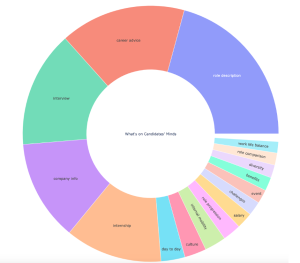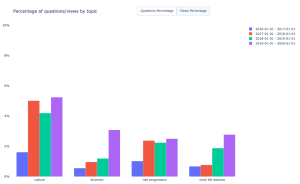In an age driven by profitability and quarterly reports, there’s only one true competitive advantage left in business: your people.
As organizations emerge from the COVID-19 crisis and begin to once again attract and retain top talent, being able to deliver on what your audience truly wants has never been more important. The challenge will be figuring out what has always been a priority versus what has now become even more critical.
In 2016, PathMotion, a recruitment tech company, set out to discover what candidates were asking of employers on its platform, which allows prospective talent to interact with employers via content, questions, and in group or one-on-one chats.
Over the course of four years, PathMotion examined which questions candidates most frequently asked employers, as well as what type of content and subject matter was most prevalent. The company looked at over 20,116 unique conversations and analyzed 2.9 million candidate questions to generate insights.
From the importance of embracing stories of adversity to recognizing the power of job descriptions, the findings reveal a number of poignant truths about the current state of employer branding and candidate experience.
What’s on Candidates’ Minds?
PathMotion’s analysis of questions that candidates were asking employers during the application process reveals the following areas of inquiry:

As we can see, candidates are most often requesting information about the job role and the company itself. That these two subjects comprise the most frequently asked questions leads to a troubling conclusion: If candidates can’t find this information on their own, then this suggests that careers websites are failing to arm people with the right details. This is especially problematic because when it comes to employer branding, your careers site and job description pages are some of the most valuable assets in the entire talent acquisition journey.
To make sense of this, I often like to provide a simple marketing analogy: From an e-commerce perspective, the job ad is essentially your product page. This holds all the power and responsibility to potentially convert someone into a customer (candidate). In digital marketing, product pages are split-tested, measured, refined, and honed on a weekly (and sometimes daily) basis.
In recruitment, however, problems abound. Job description pages are often spit out of an ATS without any real thought given to content, messaging, or conversion. This places an emphasis on quantity over quality of applications.
Research from Allegis Group, for example, shows that 72% of hiring managers say their companies provide clear job descriptions, yet only 36% of candidates say the same. This gulf in perception can lead to holes in your talent acquisition net, causing well-suited applicants to drop out and ill-equipped candidates to apply.
A well-crafted job description page, then, can be used as a smart filter in your recruitment funnel, helping you to repel unsuitable candidates and compel the right cultural fits.
The Rising Importance of Daily Life at the Organization
Findings also show that since 2016, candidates have been viewing more content about life in organizations. As the focus on transparency and authenticity has grown, so too has the desire by candidates to “lift the veil” on what it’s really like to work at companies.
Forget ping pong tables and flat-screen TVs. Today’s candidates have a genuine curiosity for the things that truly matter to them, from workplaces challenges to workforce diversity. All of these elements coalesce to form a wider perception of employer brand identity.

The chart above demonstrates exactly how candidate content viewership has changed since 2016. We can see that:
- Culture-related content is now viewed by candidates three times as much as it was in 2016
- Diversity-related content is accelerating at the fastest pace of change, with candidates seeking this information at a rate of nearly four times the level in 2016
- Work-life balance content viewership has tripled in the past four years
These trends indicate a wider shift toward authentic communication. With more transparency across digital and social platforms, employers today need to be open and honest about what it’s really like to work at their organizations. Moreover, 83% of candidates today say the authenticity of company content impacts their level of trust in that organization.
To build an employer brand that resonates with candidates on an intimate level, you need to create affinity and empathy for personal circumstances. Real, human stories that demonstrate empathy and compassion can help you achieve this. Even the smallest stories that highlight personal circumstance can connect with candidates in ways that big-budget marketing or employer brand campaigns cannot.
To unearth stories that will resonate with prospective talent, make sure to ask employees questions that provide a well-balanced view of how people find purpose, impact, and belonging. Then, to bring these stories to life, you can apply the “feel-felt-found” technique, which helps capture and distill universal themes and messages into a simple and relatable formula. It can be broken down as:
- “I know how you feel.”
- “I found the same thing. I felt the same way.”
- “I found that when I did this, I felt much better.”
This narrative arc is incredibly powerful, because it conveys the human values with which we all identify.
The Impact of COVID-19
When it comes to building a powerful end-to-end candidate experience, you absolutely must understand which questions candidates want answered along their journey.
Pre-COVID world, the top five areas that candidates wanted to know more about were:
- Interview (26.1%)
- Company (18.5%)
- Culture (12.9%)
- Role description (12.2%)
- Open positions (6.2%)
The pandemic, however, has caused candidate queries to shift. Before COVID-19, 26% of candidate questions were related to the application and interview process. Since the crisis started, that number has dropped by a whopping 10%, while questions about the company and role rose by 15%. Collectively, this trend indicates that job security and company reputation are now front-of-mind for candidates.
Employer brand directors and talent acquisition professionals who attended this year’s RallyFwd conference agree. In fact, 75% of attendees believe that over the next three to six months, “a company’s stability” and “how a company treats its employees during COVID-19” will be most important to job-seekers.
But it’s not just candidate attitudes that are changing. A profound level of change is occurring within organizations, too. Consider this: 81% of talent acquisition professionals believe that their “company culture will change as a result of the COVID-19 pandemic.”
As such, employers need to pivot and focus on satisfying basic human needs for stability and security. You can do this by doubling down on core values related to belonging, purpose, and impact.
- Belonging. By leaning into the harsh realities and truths of what it’s really like to work at an organization, you can more easily provide a sense of belonging. Your employer brand should showcase the work ethic, personality, character preferences, values, and behavior of people.
- Purpose. To embed purpose in the workplace, you need to identify and articulate what’s at the end of any struggle, challenge, or adversity. In short, you must answer the question of “why?”
- Impact. At a time of great uncertainty, it’s likely that individual impact is increasingly important. With many staff on furlough, other employees have been forced to step up. This streamlining of the workforce has undoubtedly led to a greater sense of recognition for the impact that one’s work has on the wider business.
Ultimately, stories of overcoming challenges and seeing hard work can pay off with tangible impact. They can also inspire existing employees by building a mutual affinity for each another.
